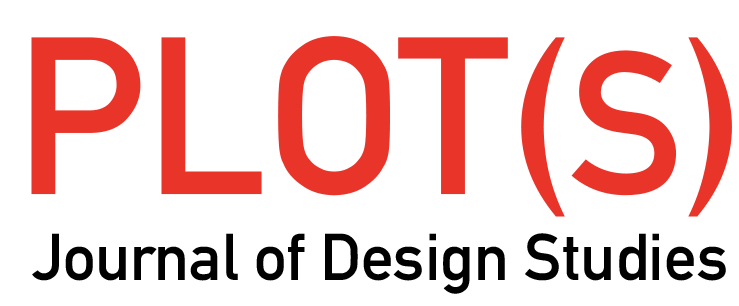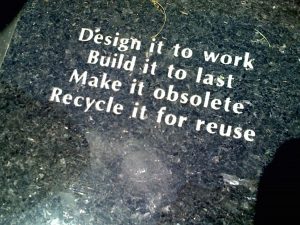A Manifesto for Transdisciplinary Designers
Rachel M. Murray
We wrestle with wicked problems that plague our complex adaptive systems while operating in constant, continual rapid acceleration. Those systems are based on services, processes, and experiences in addition to products–that design, as Bruno Latour reminds us, “has been extended from the details of daily objects to cities, landscapes, nations, cultures, bodies, genes, and […] to nature itself.”1 Yet the primary paradigm of design still remains the ideation, production, distribution and consumption model of products, and this model is not enough to solve the problems within these systems. We must rethink design as production of artifacts to instead include outside the artifacts—the environment around it and its political dimensions and values. As designers this means embracing some values and rejecting others, if we are to design for that environment and address those problems.
What does it mean to create a manifesto for my future as a designer? It means analyzing and codifying my values, but also understanding what it means to have a voice as a designer. What are my values, my voice? Asking this is terrifying— not only for myself, but for all designers. However, it must be done. And this is the time that is desperate for it to be done.
The Value of Politics
The primary value for a designer to embrace in the future is power. We need to view power and politics as the heart of our design work because design is about change. Designers assess the current, “as is” state and transform it to a future, “to be” state, an act Herbert Simon sees as “devising of courses of action to move from existing to preferred situations.”2 Implicit in designing is the act of transformation, an inherently political act. The act of revising is an indictment that the original needs improvement. Similarly, in creating something new, we use an opportunity to create that which has not been recognized, addressed, materialized—or seized upon. Both are political.
The political dimension is more than just at the heart of design—it’s at the heart of all of us. We need to recognize the political nature of our inner biases and assumptions, as well as the tools, languages, and systems we use to create. More obviously visible is the ‘outer’ political nature of our designs—our clients and how they use our work. No matter our lens, we must recognize that design is infused with politics, understand ways design can address inequality, and involve those whose voices are not part of our designs. I am tired of not being able to ask political questions about my design work and its consequences, tired of my fear of asking and incorporating the political.3 Politics will not be erased from design; what can change is my willingness to be more daring in publicly querying and recognizing the political in my work. We need to learn how to use design to understand the power structures that harm people as our systems become more complex and our resources limited. The task isn’t to move towards a particular political ideology, but rather to become more aware of the political dimension and to actively question it.
Much like campaign finance reform lies at the heart of American politics, designers need to understand what politics lie at the heart of our designs. How we order a city speaks to how we value ourselves. Politics and its shaping of design will influence how we survive or don’t survive. In concrete terms, politically influenced design has numerous examples—from using design to visualize relationships (such as Theyrule.net), to more awareness-based efforts such as the Designers Guild for Justice. While these efforts are laudable, the goal should be in asking political questions rather than assuming policy makers will ask and answer the questions for us. We must all take a more active role in the tending of the garden of society.

Figure 1. Bangladeshi Garment workers send their solidarity to Wisconsin USA public sector workers.
The Value of Holism
The recognition that design is inherently political is a change for many designers. The need to look past the product to the ecosystem around it occurs because of scale. Using scale allows us to view systems connected to one another via networks—the ‘blood’ of those systems. Viewing the whole via holism allows us to view systems interacting with other systems, and understand how well our design interventions perform. Charles and Ray Eames’s Powers of Ten film is disorienting, as scale usually is. But we must think about scale and networks if we ever want our design interventions to have a meaningful effect in our complex adaptive systems, to create more distributed networks that are resilient, rather than the fragile, like those inherent in centralized and decentralized networks.4
Scale is also about relationships and interactions within systems. The dominant paradigm of design has been creating an artifact that is consumed, viewed, experienced, used, and on some level “finished.” It is the future that must look past transactions to a deeper view of a supply chain to consider the ethical costs of design. Transactions exist in a world of networks and multiple systems, and we need a larger, holistic view to understand them fully and understand their ethics. McKenzie Wark identified the “infrastructure unconscious,” the idea that much of our built environment is unconscious or invisible to us.5 By mapping and visualizing the data, information, and knowledge in our systems, we can make the invisible visible and identify the frailties in those systems. Mapping is part of measuring the health of those systems. Anything can potentially be invisible, for a variety of reasons—including finances, voices, and values. Our role as designers is to dig and surface the invisible to help us understand the visible more and the connection between the two. Concrete examples where the invisible becomes visible are data visualization tools such as Socialexplorer. com which bring data and maps together, allowing people to explore results and relationships using socio-economic indicators. This is design as an active type of meaning creation and sensemaking which facilitates the ability to view things—including systems—holistically. We will be able to measure if our design efforts are successfully incorporating the value of holism when our design work considers maps that address scale and visualization of the networks of our systems as being a default step in our work—not just if we’re creating another ‘geospatial app.’ We must consider complex adaptive systems the ultimate goal of design. I endeavor to open my eyes and mind to this, and if see nothing in front of me, to ask what can be made visible by my design expertise.
The Value of Transdisciplinarity
To think holistically, we must be willing to rethink how we design. Design has embraced innovation in methods, tools, and processes, but no discipline can escape the dangers of siloed thinking as it becomes standardized—and those standards come at a cost.
In a disciplinary context we would often have gone with the first option that came to mind. On the one hand, interdisciplinarity forces us to rethink, to constantly widen our discussions, to resist the urge to go with the easiest choice, to try to change perspective, or to view the issues from a metalevel.6
Transdisciplinarity is about understanding complex adaptive systems with an open minded, holistic approach. Audre Lorde implored us to understand that the methods and tools we choose can affect the success of our outcomes—that the “The Master’s Tools Will Never Dismantle the Master’s House.”7 If the socio-economic problems in these systems are to be addressed, we will need more effective ways—some new, some improved—to create better analyses and solutions. One improved way is via transdisciplinarity. Being a transdisciplinarian means diving into thinking and making; reframing the research, analysis, synthesis, sensemaking and solution making, and moving towards better ways of designing. One way transdisciplinary design succeeds is in embracing modeling and simulation approaches like prototyping. Yacov Haimes states that in order to tell the “truth about the unknowable complex nature of emergent systems […];” it requires intellectually bias-free modellers and thinkers who are empowered to experiment with a multitude of modelling and simulation approaches and to collaborate for appropriate solutions.”8 Those empowered “modellers and thinkers” are the transdisciplinarians who seek to improve their craft while designing. We must endeavor to look at any approach with a critical lens and think of ways to improve. Transdisciplinary designers welcome that lens, as self reflection can ensure our profession evolves to meet the complexities of the domains in which we work.
As I identify strongly with being a transdisciplinary designer, I doubt I will need reminding in the future to embrace the “critical reframing, systems diagramming, scalar thinking, experimental prototyping and a reflective practice” and other competencies identified by Jamer Hunt as key to transdisciplinary design.9 What I can do as a designer is to endeavor to contribute and evangelize it. This translates to educating others on what the discipline offers—not only clients and end users in complex adaptive systems—but also designers who may have never heard of transdisciplinarity. In a concrete form, it means creating more examples like the Transdisciplinary Design at Parsons The New School for Design program to spread the framework of thinking, and perhaps also reframing how we can best teach the practice in a variety of formats and durations to ensure that audiences outside of academia are reached. Evangelism for the discipline ensures my future designing demonstrates my values—a reaffirmation of why I value transdisciplinary design so highly, as a guiding way of life for my design practice. We will be able to measure the success of transdisciplinary design when fewer people look at the words with puzzlement, and instead agree with a strong affirmation of the value of the endeavour—and a righteousness that wonders why there isn’t more of it.
Figure 3. Disaster simulation exercise in one of the Transdisciplinary Design program’s studio taught by Mathan Ratinam. Image courtesy of the author.
The Value of Openness
The ability to transcend one’s discipline is about the openness to possibilities outside our comfort zone. That openness means we must evolve the designer’s toolbox to include not just paint, sketchpads, and software, but the sensors, code, and operational systems of our future worlds. If we see scale and networks as our focus, we will need to transition away from only using traditional tools and approaches, and instead keep our eyes, hands, and mind open towards incorporating the new. Global systems and personal ubiquitous computing mean increased technology use in our designs, and as more data is created via sensors, we’ll need better tools to analyze, model, visualize, and create meaning.10 Complex adaptive systems need models that reflect socioeconomic complexity and information flows—but our toolbox struggles to keep up in modeling that complexity, something Latour identified as a problem:
So here is the question I wish to raise to designers: where are the visualization tools that allow the contradictory and controversial nature of matters of concern to be represented? What is needed instead are tools that capture what have always been the hidden practices of modernist innovations: objects have always been projects; matters of fact have always been matters of concern. The tools we need to grasp these hidden practices will teach us just as much as the old aesthetics of matters of fact—and then again much more. Let me be clear—I am not advocating another CAD design for Prometheus. What I am pressing for is a means for drawing things together— gods, non humans, and mortals included. Why should this prove to be an impossible task? Why can the powerful visual vocabulary that has been devised in the past, by generations of artists, engineers, designers, philosophers, artisans, and activists for matters of fact, not be devised (I hesitate to say restyled) for matters of concern?11
Latour noted that “we are still utterly unable to draw together, to simulate, to materialize, to approximate, to fully model to scale, what a thing in all of its complexity is.”12 Much has changed since 2009, but we still suffer from inadequate models because we fail to think about making our design-work as physical as our world. Data physicalization—the creation of “physical representations to help people explore, understand, and communicate data using computer-supported physical data representations” is a concrete example of where our work as designers can head.13 In order to understand the data and information flows in our systems, why not create models which visualize in real time and in physical space what a system is doing, and understand how to incorporate strategic work like scenario-planning in the domain of design as well? As a designer, this means embracing new skills as part of my toolbox and not being afraid of them, since ultimately they help create better solutions for our systems. Not only must those tools change, but also the way we deliver the solutions—to explore role-playing, games and play.14 We’ll be able to measure the success of how open we are by understanding if our tools are becoming as vivid as our realities.
Not only must our technology change, but perhaps our languages for thinking about systems need evolution. We may need new classifications and ontologies, especially for the “long-standing ontology of the social world” to map out the terrain of complex adaptive systems.15 Thinking politically, will they be languages of inclusion (whose voice is included in official histories?) with a goal of being an “improved linguistic grasp?”16 The choice will be up to us.
Figure 4. Image from Neurotica Records courtesy of the author
The Value of Balance
We have come full circle, from politics to holism to values of transdisciplinarity and openness. Where is the human ultimately in this discussion? In balance, and for designers, the balance will shape our role in the future, help the pendulum swing more towards co-creating via participatory design with clients and users. We can no longer be domain experts in black turtlenecks who fly in and out of our client’s lives after our work is done. We need to truly listen to their voices and incorporate them more actively in our designs.
From changes in creation due to crowdsourcing, changes in consumption with collaborative consumption/the sharing economy, to distribution with 3D printing, rapid changes are happening in design. Yet we haven’t seen rapid adoption of participatory design, especially in the U.S. (sometimes only for a workshop at the beginning of work, but not the duration of the project). We should instead look to the models of “with, not for” co-creation with clients, a concrete example being Massachusetts Institute of Technology’s Center for Civic Media and others in the civic innovation/civic design communities who stress co-creation.
The era of designer as maker-of-product should transition to designer as modeler, analyst, system/process/service creator, with client as partner, using their expertise and personal experience. The change is ultimately towards designer as doula—a midwife who shares expertise in storytelling, analyzing, organizing, visualizing, and helping clients and their communities tell their own story. Similar to my reluctance to see the political in design, I must challenge my reluctance to truly fight passionately for co-creation in my work and to have my end users alongside me.
For some, this may seem like giving up control, but a shift towards co-creation is about becoming comfortable with ambiguity. We can use design to understand and prepare for uncertainty, ambiguity, and unintended consequences, and to recognize we will never be able to control—and design—everything. For a designer perhaps that is the most painful metric of all—to recognize that while we should strive for balance, we must also accept ambiguity inherent in our work, and that the measure of success may never be resolved because our wicked problems are unsolvable. Not because they are mathematically difficult, but because we can’t define them well enough to quantify things. Design will help us accept sharing control with others as a starting point, to evolve as designers and citizens, and to ultimately reform design itself. In the end, we can reject the need to control, just as we can reject the politics and design of fear, distrust, cynicism, division, and inequality. We can also choose to favor hope— the transformative power of design to improve and create solutions—and even love, as clichéd as that may sound. But to evolve and become a designer who designs from hope and love, I will need to start with myself.
Figure 5. Image of York St. station, courtesy of the author.
Someone’s been hiding the pieces
Someone been burning down the trees
So we need your revolution, baby
There’s a planet to set free
We are the revolution, baby
Come to take you home
If you say you want a revolution, baby
There is nothing like your own
World Party, Private Revolution 17
Karl Wallinger
Private Revolution London
Chrysalis Records
1986
Endnotes
1. Bruno Latour, “A Cautious Prometheus? A Few Steps Toward a Philosophy of Design (with Special Attention to Peter Sloterdijk),” in Proceedings of the 2008 Annual International Conference of the Design History Society, ed. Fiona Hackne et al. (Florida: Universal Publishers), 2-10. ↵
2. Simon, as cited in Susan Yelavich, Barbara Adams, Design as Future-Making (New York: Bloomsbury Publishing, 2014). ↵
3. Perhaps this is one of the reasons why I came to this institution – as much for the New School as for Parsons, and the sense of history that comes with the New School story as a sanctuary and a place of exploration for intellectuals committed to political activism. What better place to understand how to bring the political into my design work than a place with a history of progressive thought as well as a design school. ↵
4. Paul Baran, On Distributed Communications: I. Introduction to Distributed Communications Networks (Santa Monica, CA: RAND Corporation, 1964), http://www.rand.org/pubs/research_memoranda/RM3420. ↵
5. McKenzie Wark, “Climate Science as Sensory Infrastructure,” The White Review, August 2014, http://www.thewhitereview.org/features/climate- science-as-sensory-infrastructure/. ↵
6. Audre Lorde, Sister Outsider: Essays and Speeches (Freedom, CA: The Crossing Press, 1984). ↵
7. Nick Bostrom and Milan M. Cirkovic, Global Catastrophic Risks (London: Oxford University Press, 2008). ↵
8. Jamer Hunt, “Letter from the Editor,” The Journal of Design Strategies 5:1 (Spring 2012): 5-10. ↵
9. Charles Stross, “How Low (Power) Can You Go?,” Charlie’s Diary, http://www.antipope.org/ charlie/blog-static/2012/08/ how-low-power-can-you-go.html. ↵
10. Latour, “A Cautious Prometheus?,” 13. ↵
11. Ibid., 18. ↵
12. Yvonne Jansen and Pierre Dragicevic, “Data Physicalization,” Data Physicalization Wiki, http:// dataphys.org/. ↵
13. Roberta Tassi, “Role Play,” Service Design Tools, http://www.servicedesigntools.org/tools/42. ↵
14. Orit Halpern et al.,“Test-Bed Urbanism,” Public Culture 25:2 (2013): 272-306. ↵
15. Halperin et al., “Test-Bed Urbanism,” 303. ↵
16. Robert Lucky, “Wicked Problems (Reflections),” IEEE Spectrum, http://spectrum.ieee.org/at-work/innovation/wicked- problems. ↵
17. Karl Wallinger, Private Revolution London: Chrysalis Records, 1986. ↵
Author Affiliations
Rachel M. Murray
MFA student, Transdisciplinary Design, Parsons School of Design.

 DESIGN STUDIES BLOG
DESIGN STUDIES BLOG


